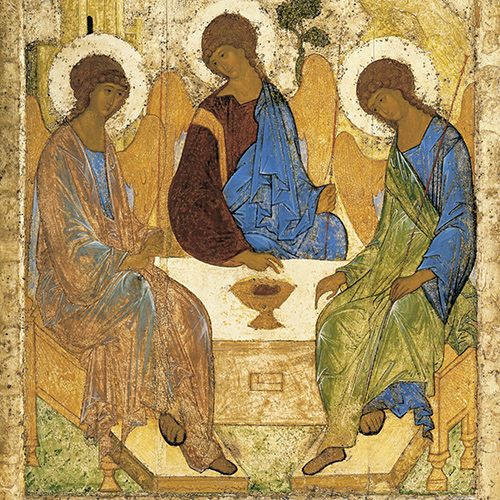
The Holy Trinity by Andrej Rublëv, 1411
The evolution of Russian art is inextricably bound to the rich cultural exchanges between East and West. These resulted in a fascinating blend of diverse visual languages and styles, from the late-medieval icons and frescos indebted to Byzantium to the great avant-garde experiments of the early part of the 20th century that developed side by side with the various currents of modernism in other parts of Europe.
In this four-part course, art historian Aneta Georgievska-Shine brings the culture of this vast country to life as she highlights some of the major art developments in Russia over the centuries.
February 6 Icons
The language of icon paintings was introduced to Russia via Byzantium, where it developed as an expression of the theological and artistic concerns of the Eastern Orthodox Church. Like the Byzantine icons and other religious images from Constantinople, those created in Russia reflect a visual culture that promoted prayer and contemplation, rather than a representation of the material world.
February 13 Russian Art and the Western Academic Tradition
By the 19th century, the visual culture of Russia was fully informed by the academic painting of Western Europe. At the same time, it became significantly concerned with liberal movements for social reform—which led to a heightened emphasis on realism, whether in the depiction of expansive landscapes or scenes based on daily life.
February 20 Modernism
As the 19th century drew to a close, the exchanges between Russian painters and their peers in artistic centers such as Paris gave rise to an amazing range of avant-garde styles. As a result, Russian artists found new vehicles to express strikingly individual perspectives on the world through a dramatic departure from naturalism and a focus on a new, purely artistic reality of forms, lines, and colors.
February 27 Art and Revolution
The tumultuous decades of the 20th century that led to the establishment of the Soviet Union were just as revolutionary in an artistic sense. Countless progressive-leaning artists put their creative efforts in service of the ideology promoted by the Bolsheviks in painting, sculpture, and architecture that aimed to express the thorough transformation of society that they desired. Within a decade, their dreams were brutally dispelled by the advent of Socialist realism, which became the only artistic style sanctioned by the state.
4 sessions
World Art History Certificate core course: Earn 1 credit*
General Information
*Enrolled participants in the World Art History Certificate Program receive 1 core course credit. Not yet enrolled? Learn about the program, its benefits, and how to register here.